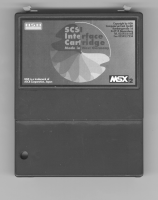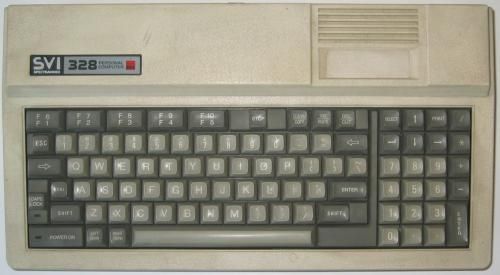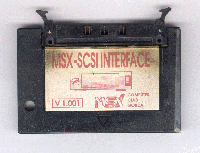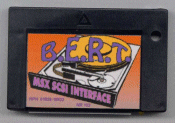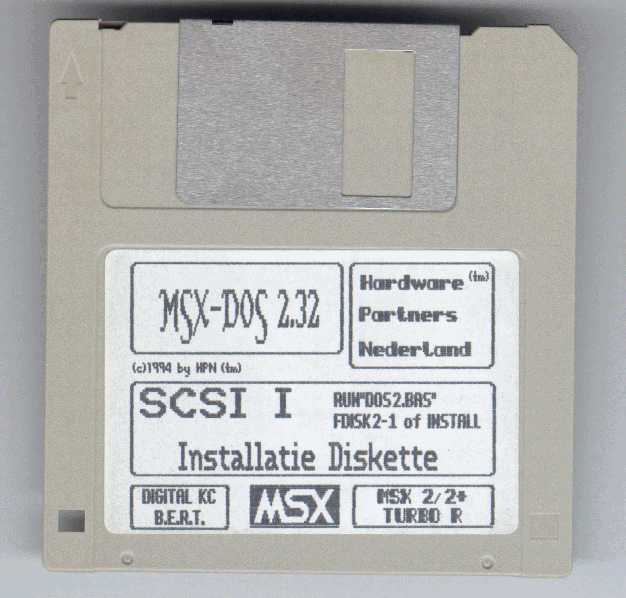MSX SCSI Interfaces were the first methods to add hard disks to MSX computers.
All MSX hard disk systems require MSX-DOS 2, except the HSH V1.0. Since a hard disk without subdirectories is not very usefull (the maximum amount of files in the root is very limited) a MSX-DOS 2 cartridge ROM is required. Only the later B.E.R.T. versions have the MSX-DOS 2 builtin.
There are two families described here:
- HSH, MAK and MSX Club Gouda, based on the Western Digital chip WD33C93A and the Novaxis ROM
- B.E.R.T. based on the Zilog 5380 scsi controller chip
The Mega-SCSI is a japanese design and is a very fast and capable MSX SCSI controller. Look at Takamichi’s page for translated documents.Designed in Japan by ESE Factory. See their webpage. Datasheet of the Fujitsu MB89352 the SCSI controller of MegaSCSI
SCSI
The SCSI-1 Standard as used in the MSX controllers is the first ANSI standard defined for the Small Computer Systems Interface, dated 1985 and nowadays called narrow SCSI or SCSI-1. Narrow because it has a parallel 8 bits databus. The SCSI-2 standard is more advanced and contains some facilities that can be useful also on the narrow SCSI in the MSX.
Background information (all you wanted to know or find about SCSI)
What is SCSI?
SCSI stands for Small Computer Systems Interface and is pronounced “Skuzzy”. It’s a standardized way of connecting hardware peripherals to a computer using standardized hardware and control commands. The standard can be divided into SCSI-1 (standard SCSI) and higher SCSI versions
The devices on the SCSI bus talks to the computer through one of the devices connected to the SCSI bus. That device is called the controller and has an interface to one of the data buses of the computer. Besides disk drives, today’s SCSI standard supports several other devices. Examples are removable media devices (CD-ROM, CD-R, Zip drives), video frame grabbers, scanners and tape streamers (DAT, DLT).
Each SCSI device can have multiple logical sub-units (LUNs) which can be quite handy when using CD changers (both readers and burners) or tape arrays but most units have only one logical unit like hard drives and single disk CD-ROMs. All devices have the ability to release the bus after beeing requested to do time consuming operations not requiring the availability of the bus and leaves it free for other devices to use for transferring data or receiving commands.
The most common type of connector for SCSI-1 is the Centronics 50, also called Telco 50 or Amphenol 50 (for external use). Internally, SCSI-1 is always run on Dual-Row Socket (F) connectors on a 50 conductor ribbon cable, and this is what all MSX SCSI interfaces use.
Standards
ANSI defines the SCSI standards which describe the characteristics and capabilities of the interface. There are currently two main standards, SCSI-1 and SCSI-2. SCSI-3 is a family of standards and the reason is that it got too difficult and time-consuming to define one standard, instead SCSI-3 comprises different layers and command sets which allowed SCSI substandards to evolve and complete separately.
SCSI-1
This is the original SCSI standard from 1986 and defines cabling, command sets and transfer modes. It uses an 8-bit wide bus where data transfers are done with a max.5 MHz clock resulting in 5 MB/s peak transfer rate. At most 8 devices can be connected to the bus as a direct consequence of the bus width as each device is addressed using one of the 8 data lines. Most devices used on this bus are hard drives as the command set doesn’t explicitly support other media in the command set.
HSH
The first MSX SCSI Interface commercially available, from the german firm HSH and sold in the Netherlands by the dutch magazine MCM.
Here is the utilities disk with FDISK V1.07
With older versions of the MSX Club Gouda and MAK the FDISK 1.06 (dutch and english guide) was distributed
The HSH SCSI userguide in english is a worthwhile introduction and describes the use of FDISK and the SCSI network.
There are at least two revisions made of this interface.
The HSH interface is based on the Western Digital chip WD33C93A, registers start at i/o port #34.
WD99C93 SCSI IC
AMD version AM33C93 SCSI chip datasheet as used in MSX HSH, Green, MAK, MSX Gouda Novaxis SCSI controllers.
Datasheet of the WD33C93 , the Western Digital original
The MST members Ries Vriend and Ramon van der Winkel disassembled and improved the HSH diskrom and made a version working on the turboR.
MAK/Sparrowsoft
These controllers made by Sparrowsoft/MSX Aktief Kampen are based on the same chip Western Digital chip as the HSH and use the same i/o ports.
The print layout and port decoding are different, the connector is not gold-plated.
You can use the HSH Fdisk utility disk.
Some utilities to help with MAK boot problems are in this archive.
MSX Club Gouda
A MSX SCSI Interface with many versions and many firmware revisions, latest is the Novaxis diskrom.
Also a Western Digital chip based unit with the same I/O ports (there was a small production with other I/O ports like #1C)
![]() Tools inclusing CD support.
Tools inclusing CD support.
![]() All files of the MSX DOS 2 bootable disk as distributed with the interface.
All files of the MSX DOS 2 bootable disk as distributed with the interface.
![]() Read here the userguide of NFDISK, Novaxis etc.
Read here the userguide of NFDISK, Novaxis etc.
Older versions were limited to work on turboR only.
Lots of programming information and sources by Roderik Muit and Gert de Boom in the sources section.
Henrik Gilvad made the first version of the interface and wrote several utilities like CD (audio) tools for it.
NOVAXIS
Novaxis is not the name of a SCSI interface but the name of the ROM for WD33C93A based interfaces at port #34.
MSX Club Gouda (Jurgen Kramer) improved the ROM of their SCSI interface and renamed this to NOVAXIS.
Read here the userguide of the Novaxis ROM and here the original Wordperfect version of the guide with separate example files.
![]() Source of Version 1.50 of the Novaxis ROM by Jurgen Kramer
Source of Version 1.50 of the Novaxis ROM by Jurgen Kramer
![]() Novaxis utility to convert B.E.R.T. partition table to NOVAXIS format and reverse (Marcel Delorme)
Novaxis utility to convert B.E.R.T. partition table to NOVAXIS format and reverse (Marcel Delorme)
![]() Novaxis programming information
Novaxis programming information
![]() Some Novaxis ROM images in this archive:
Some Novaxis ROM images in this archive:
- NOVAXIS 03-07-95 ROM, regular version 1.5?
- NOVAXIS 25-08-96 1.59.64 ROM, improved version 1.59
- NOVAXIS 14-05-95 ROM modified (by Marcel Delorme) version which increases read speed with 20% for MSX-2, not suitable for turboR.
B.E.R.T. SCSI interface
MSX SCSI Interface, a product still being sold by Hardware Partners Nederland, supports SCSI hard disk, ZIP drives, CDROMS
|
|
|
| B.E.R.T. V2.7 | B.E.R.T. Utility Floppy |
For V2.7 one of Differences is when you take 1 HDD at ID0 and you put more MSX machines with each a BERT SCSI interface and you tell the HDD with the partition rights configure per ID.
You can tell the HDD that ID7 has partition 0 is only for ID7 and not for the other ID’s
You can do this for each differend MSX with each a BERT SCSI interface
MSX number 1 with ID7 > partition 0
MSX number 2 with ID6 > partition 1
MSX number 3 with ID5 > partition 2
MSX number 4 with ID4 > partition 3
MSX number 5 with ID3 > partition 4
MSX number 6 with ID2 > partition 5
MSX number 7 with ID1 > partition 6
Each partition can have a MXS-DOS 2 version on it.
Could even be a different MXS-DOS 2 version 2.20, 2.31 or 2.44
When you start each MSX, it is like every MSX got it’s own HDD.
The problem was, when you write the same file with each MSX in the same partition, the file came corrupted, in the 2.7 version this is solved.
The second problem was, when a diskette was formatted, the disk wasn’t 713 Kb when formatted and empty.
In the 2.7 version was this problem also solved.
B.E.R.T. utilities (unpacked utilities disk)
B.E.R.T. utilities (original disk supplied with B.E.R.T. and a copy of utilities from my hard disk.
B.E.R.T. user guide page
B.E.R.T. userguide and documentation
B.E.R.T. fdisk 2-1, older MK ROM with disassembly by Floris van Gog
Bert Hoogenboom has made the sources of the B.E.R.T. interface available and gave permission to publish.
Maarten Verheijdt has made the sources of FDISK for B.E.R.T. available, also permission to publish.
B.E.R.T. Bios description
B.E.R.T. Workarea description
B.E.R.T. partition description
The datasheet of the 5380 SCSI controller in the B.E.R.T. interface (by Zilog, also made by many other semiconductor factories)
B.E.R.T. hardware circuit diagram (from the HPN site by Hans Oranje )
B.E.R.T. ROM V2.7 for MSX-2 (fits in 27C512)
B.E.R.T. ROM V2.7 for turboR (fits in 27C512)
or place both ROMS in a 27C1000 with a switch for the different ROMs.


